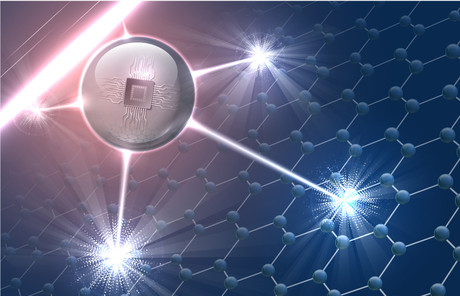Molecular electronics on the horizon

We may not be able to cram any more processing power into silicon-based computer chips, but we can make electronic devices 10 times smaller and use molecules to build electronic circuits instead.
That’s according to an international research team led by IBM Research – Zurich, who have developed a new technique to fabricate microelectronic devices by electrically contacting molecules at two well-defined termini.
As the miniaturisation of silicon technology continues, devices which offer more than the on/off functionality of a transistor become more attractive. Molecular electronics, which aims to use molecules to build electronic devices, offer exactly this advantage, allowing a chemical tailoring of the device response. This is useful not only for emerging computing paradigms such as neuromorphic computing, but also for highly specific sensors based on molecular recognition or quantum effects.
Molecular devices are a reality in the laboratory, but the step towards first commercial applications has been severely hampered by technological difficulties. Scientists simply haven’t been able to make a stable device platform for molecules to sit inside which could reliably connect with the molecules, exploit their ability to respond to a current or be easily mass-produced.
Now, the IBM Research team has developed a proof-of-concept device which they say addresses all these issues. Writing in the journal Nature, the researchers explained how they addressed previous limitations using a technique that allows molecules to be compartmentalised into dielectric pores and electrically contacted.
A type of sandwich construction was used in which a layer of molecules was brought into contact with metallic electrodes from above and below. The lower electrode consisted of a layer of platinum lithographically patterned onto a conventional silicon wafer, which was coated with a non-conducting material. Tiny pores of arbitrary diameters were then etched into this dielectric layer to expose a defined area of the bottom electrode.
The researchers then took advantage of the ability of certain molecules to self-assemble onto surfaces. When placing the wafer in a solution of molecules, these molecules self-assembled on the open platinum areas. The resulting monolayer of upright, regularly spaced molecules was electrically connected to the bottom electrode by the covalent anchoring groups.
To perform the crucial step of creating a top-contact without destroying the molecular layer, a film of metallic nanoparticles was deposited directly onto the molecules. This layer allowed a bulk electrode to be added using conventional methods, creating thousands of stable metal-molecule-metal junctions without compromising the properties of the molecules.
The new technique thus resolves the problems that previously hampered the creation of electrical contacts to molecules, including high contact resistances or short circuits by filaments penetrating the film. Building blocks fabricated by this inexpensive and mass-production-compatible method can be operated under ambient conditions and provide long-term stability.
The researchers demonstrated their approach using alkane-dithiol molecules made up of carbon, hydrogen and sulfur; their next goal will be to test the platform with different molecules that have different functions to see if they can make it work. If successful, their technique could lead to molecular compounds being integrated into solid-state devices that could be scaled down to the size of a single molecule, including new electronic devices and instruments in the fields of sensor technology.
“Imagine a miniaturised transistor made up of several single molecules,” said Koushik Venkatesan, an associate professor at Macquarie University and co-author on the study.
“That’s the promise of molecular electronics — devices that are smaller, faster, have more memory and are cheaper to make.”
Koushik is confident that the team’s research will open up the bottleneck for molecular-based technology to move forward, claiming, “The electronic buildings blocks of the future will be molecules.
“Molecular electronics hasn’t previously lived up to expectations, but we’ve seen a renaissance of the field in the last five to six years,” he said.
“The device platform is the missing link. We hope work like ours will accelerate this type of technology.”
Light reshapes semiconductors for advanced optical devices
Researchers have shown how light reshapes Janus semiconductors at the atomic scale, enabling...
Novel method to grow ultrathin semiconductors on electronics
Researchers have developed a technique that could speed up the development of next-generation...
Blue LEDs developed to enhance display performance
Researchers have developed a new method for manufacturing light-emitting diodes (LEDs) that emit...




